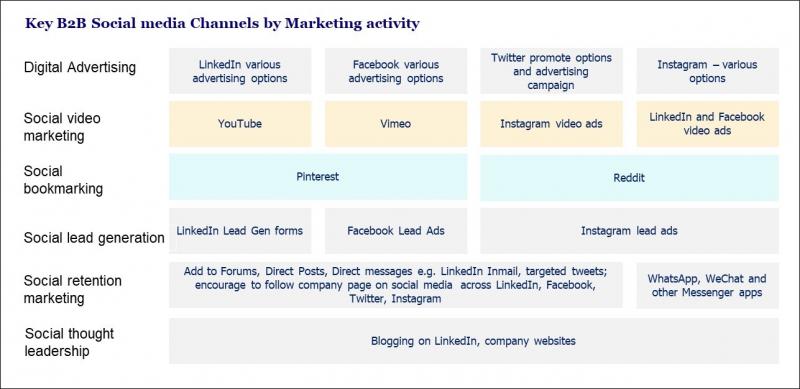Implementing Social Media into Your B2B Digital Strategy

Before implementing social media into your B2B digital marketing strategy, you should first consider the possibilities that social media offers, as well as the main objectives and goals of your B2B digital marketing strategy.
Setting B2B social media objectives
The social media universe now available to B2B marketers can be split according to:
a) the key marketing functions or areas
b) the key methods for digitally socializing
In terms of the key marketing areas or functions, this can be broken down into social media advertising, social video marketing, social bookmarking, social lead generation, social retention marketing and social media thought leadership. (See the below diagram).

However, social media in B2B marketing can also be categorized by the way things are communicated, including peer to peer, business communities and business groups, messaging and text, micro blogging, and video.
B2B digital marketing strategy goals can range from very broad, such as customer acquisition or customer retention, to more specific like generating awareness, generating and/or nurturing leads and retaining customers.
Really getting specific with goals will help you not only select appropriate social media channels but select the right functionality within the social media channel. For example, if a company is looking to nurture leads, LinkedIn sponsored content or native ads would likely be more suitable, whereas if one is looking to capture prospect contact information, then LinkedIn lead generation forms would be better.
Understanding how your target customer uses social media
Once you have a better understanding of the B2B social media space and your goals, the next step is to understand how your target audience currently uses social media.
Customers now use social media in almost every area of business, from purchasing, research, customers and markets, to marketing, selling, operations, partnership building and customer service.
Different social media channels will be used differently; LinkedIn, for example, is arguably a more obvious B2B social media channel. Customers may use this to identify and connect with business stakeholders, or use this network to be part of social media groups and communities (such as Procurious for purchase managers or those which have a role or interest in the purchasing space).
Through this detailed understanding of how customers use social media and the functions they use, each channel will better inform the implementation; if you know that customers use certain social media spaces to research, read blogs or use social media communities, you might consider leveraging this particular functionality of the platform.
Alternatively, if you were looking to advertize on social media, if you already know where and what is being researched, you can make sure those relevant messages and keywords are included in your adverts and videos.
Selecting the social media mix
When selecting the right social media mix, it’s important to look at specific goals and objectives, as well as detailed buyer personas.
For example, if a buyer persona highlights that the customer uses Instagram, Vimeo and potentially a messenger app in early stage research, adopting a different social mix to simply Twitter, LinkedIn and YouTube would be essential.
Generating awareness
To do this you would likely consider advertising which would come with several options in terms of platform, such as Facebook, LinkedIn, Twitter, or Instagram.
There are also now even more social media advertising options open to B2B marketers in terms of bidding and payment type. Looking at more specific advertising functions such as Ad targeting, Twitter, Facebook, and LinkedIn now all offer geographical, demographical, device ad targeting and more.
Generating leads
Social media can support the goal of generating leads through several different approaches, with some more effective for B2B than others.
For example, if you wanted to capture and nurture leads, you might be interested in using Facebook lead ads, which are ads that also serve to capture information. Alternatively, you might want to explore LinkedIn lead generation forms.
Integrating social media
Finally, to ensure social media is properly integrated between channels, hashtags can be extremely helpful (and can now be used on LinkedIn posts) – meaning you can unify your campaigns across communication channels through the same hashtag.
Integration also means integrating with other channels such as including social media widgets within relevant website pages, on email, in blogs and in mobile emails and messages.
To find out more about using social media more effectively within your digital marketing as a B2B organization, check out B2B Digital Marketing Strategy – now available.


